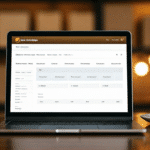Best Practices for Ecommerce Businesses to Improve Inventory Forecasting
Accurate inventory forecasting is crucial for the success of any ecommerce business. Without proper forecasting, businesses can quickly find themselves with either too much inventory or not enough. In this article, we will discuss different techniques for inventory forecasting, the pros and cons of each technique, factors that affect forecasting accuracy, steps to improve forecasting accuracy, top tools and software for accurate inventory forecasting, and real-time data adjustments. We'll also provide tips for managing overstock and understock situations and showcase case studies of successful ecommerce companies that utilize effective inventory forecasting techniques.
Why Accurate Inventory Forecasting is Crucial for Ecommerce Businesses
One of the primary challenges that ecommerce businesses face is getting the right products to the right customers at the right time. Inventory forecasting plays a critical role in meeting this challenge. By accurately forecasting demand, ecommerce businesses can ensure they have the right inventory levels to fulfill customer orders without running out of stock or having too much inventory.
Accurate inventory forecasting also helps ecommerce businesses to optimize their supply chain management. By knowing what products are in demand, businesses can work with their suppliers to ensure they have enough inventory on hand to meet customer needs. This can help to reduce lead times and improve overall efficiency in the supply chain.
Furthermore, accurate inventory forecasting can help ecommerce businesses to reduce costs associated with excess inventory. By having a clear understanding of demand, businesses can avoid overstocking and the associated costs of storing and managing excess inventory. This can help to improve profitability and reduce waste.
According to a ShipScience research report from 2023, companies that implement effective inventory forecasting techniques see an average reduction of 20% in inventory holding costs and a 15% increase in order fulfillment rates.
Types of Inventory Forecasting Techniques
There are several different techniques that ecommerce businesses can use for inventory forecasting. These include:
- Time-series forecasting: This technique uses historical sales data to make future predictions.
- Causal forecasting: This technique involves identifying data that may be impacting sales, such as economic trends or weather patterns, and using that data to make predictions.
- Seasonal forecasting: This technique involves identifying trends that are seasonal, such as holidays, and using that data to make predictions.
- Collaborative forecasting: This technique involves getting input and data from multiple stakeholders, such as suppliers and retailers, to make predictions.
It is important for ecommerce businesses to choose the right inventory forecasting technique for their specific needs. Factors such as the type of product, sales volume, and market trends can all impact the effectiveness of different techniques. Additionally, businesses should regularly review and adjust their forecasting methods to ensure they are accurately predicting demand and avoiding stockouts or overstocking.
The Pros and Cons of Each Inventory Forecasting Technique
Each inventory forecasting technique has its own pros and cons to consider.
- Time-series forecasting: Often the most accurate but requires extensive historical data.
- Causal forecasting: Helpful in identifying outside factors impacting sales, but those factors may not always be predictable.
- Seasonal forecasting: Works well for businesses with seasonal demand, but may not account for unanticipated spikes or drops in demand.
- Collaborative forecasting: Provides a comprehensive view of inventory needs but may be impacted by inaccurate or incomplete data.
It is important for businesses to carefully evaluate their inventory forecasting needs and choose the technique that best fits their specific situation. For example, a business with a long history of sales data may benefit from using time-series forecasting, while a business with a new product line may need to rely on causal forecasting to identify potential external factors affecting demand. Additionally, businesses should regularly review and adjust their forecasting techniques as market conditions and customer behavior change over time.
Factors that Affect Inventory Forecasting Accuracy
Several factors can impact the accuracy of inventory forecasting, including:
- Seasonality and trends
- Marketing and promotion activities
- Supplier lead times and availability
- Market disruptions, such as new competition or economic changes
- Unexpected changes in demand or customer behavior
Another important factor that can affect inventory forecasting accuracy is the quality of data used in the forecasting process. Inaccurate or incomplete data can lead to incorrect predictions and ultimately result in stockouts or overstocking. It is important to regularly review and update data sources, such as sales history, inventory levels, and customer feedback, to ensure the most accurate forecasting possible.
Implementing data validation techniques and integrating advanced analytics can further enhance data quality and forecasting precision.
Steps to Improve Inventory Forecasting Accuracy
To improve inventory forecasting accuracy, ecommerce businesses should:
- Set up a clear framework for inventory forecasting
- Collect and analyze historical sales data
- Consider external factors, such as seasonality, promotions, and market trends
- Utilize multiple inventory forecasting techniques to validate predictions
- Continuously monitor and adjust forecasts based on real-time data
Another important step to improve inventory forecasting accuracy is to collaborate with suppliers and vendors. By sharing sales data and inventory levels, businesses can work together to optimize inventory levels and reduce the risk of stockouts or overstocking. Additionally, businesses should consider implementing automated inventory management systems that can track inventory levels in real-time and provide alerts when stock levels are low or high. This can help businesses make more informed decisions about when to reorder products and how much inventory to keep on hand.
Implementing automated inventory management systems can significantly enhance forecasting accuracy and operational efficiency.
Using Historical Sales Data to Improve Inventory Forecasting
Historical sales data is one of the most important resources for inventory forecasting. Ecommerce businesses can use this data to identify trends and patterns that can help inform future predictions. By analyzing sales data over time, businesses can identify demand patterns by product, time of year, and customer segments and use that data to adjust their inventory levels accordingly.
Another benefit of using historical sales data for inventory forecasting is that it can help businesses optimize their supply chain management. By analyzing sales data, businesses can identify which products are selling the most and adjust their production and shipping schedules accordingly. This can help reduce lead times and ensure that products are always in stock when customers want to buy them.
Furthermore, historical sales data can also help businesses identify which products are underperforming and may need to be discounted or removed from inventory altogether. By analyzing sales data, businesses can identify which products are not selling well and adjust their inventory levels accordingly. This can help reduce waste and free up resources to invest in more profitable products.
According to industry statistics, businesses that leverage historical sales data for forecasting experience a 25% improvement in demand prediction accuracy.
How to Analyze Sales Trends and Seasonal Variations for Better Inventory Forecasting
When analyzing sales trends and seasonal variations, it's important to consider the impact of external factors, such as holidays or major events. By understanding the impact of these factors on historical sales, businesses can make more accurate predictions for future demand. For example, analyzing the impact of Black Friday on sales can help businesses better prepare for increased demand during the holiday season.
Another important factor to consider when analyzing sales trends is the impact of weather patterns. For example, a clothing retailer may see a spike in sales for winter coats during a particularly cold winter, while sales for summer clothing may decrease during a rainy summer season. By analyzing historical sales data alongside weather patterns, businesses can make more informed decisions about inventory levels and product offerings.
In addition to external factors, businesses should also consider internal factors when analyzing sales trends. This includes factors such as pricing strategies, marketing campaigns, and product launches. By analyzing the impact of these internal factors on sales, businesses can make adjustments to their strategies and better forecast future demand.
Leveraging tools like advanced analytics platforms can provide deeper insights into sales trends and seasonal variations.
Predictive Analytics in Inventory Forecasting: Benefits and Limitations
Predictive analytics is a powerful tool for inventory forecasting. It uses machine learning algorithms to identify trends and patterns in sales data, which can help businesses make more accurate predictions. However, predictive analytics may not be suitable for all ecommerce businesses, as it requires a significant investment in technology and expertise.
Despite the potential benefits of predictive analytics in inventory forecasting, there are also some limitations to consider. One limitation is the accuracy of the data used to train the machine learning algorithms. If the data is incomplete or inaccurate, the predictions made by the algorithm may also be inaccurate. Additionally, predictive analytics may not be able to account for unexpected events, such as a sudden change in consumer behavior or a supply chain disruption. Therefore, it is important for businesses to use predictive analytics as one tool among many in their inventory forecasting strategy.
Research from ShipScience highlights that while predictive analytics can enhance forecasting accuracy by up to 30%, it should be complemented with traditional forecasting methods to mitigate its limitations.
The Role of Technology in Improving Inventory Forecasting for Ecommerce Businesses
Technology can play a significant role in improving inventory forecasting for ecommerce businesses. There are many tools and software available to help businesses collect, manage, and analyze sales data. These tools can help businesses identify trends and patterns in sales data, make more accurate predictions, and adjust inventory levels in real-time.
Integrating technologies such as artificial intelligence (AI) and machine learning (ML) can further enhance forecasting capabilities by automating data analysis and providing more nuanced insights into consumer behavior and market trends.
Top Tools and Software for Accurate Inventory Forecasting
Some of the top tools and software for accurate inventory forecasting include:
- Oracle NetSuite Demand Planning
- Logility Demand Planning
- JDA Software Demand Planning
- Infor Inventory Management
- Microsoft Dynamics 365 Supply Chain Management
Additionally, ShipScience Inventory Tools offer specialized solutions tailored for ecommerce businesses seeking enhanced forecasting accuracy.
How to Use Real-Time Data to Make Rapid Adjustments to Your Inventory Forecasts
By continuously monitoring sales data in real-time, ecommerce businesses can make rapid adjustments to their inventory forecasts. For example, by seeing an increase in sales for a particular product, businesses can quickly adjust their inventory levels to ensure they don't run out of stock. Real-time data can also help businesses identify unexpected changes in demand and adjust their forecasts accordingly.
Implementing real-time data analytics allows businesses to respond swiftly to market fluctuations, ensuring optimal inventory levels and improved customer satisfaction.
Tips for Managing Overstock and Understock Situations with Effective Inventory Forecasting
Effective inventory forecasting can help ecommerce businesses avoid overstock and understock situations. Businesses can use sales data to identify products that are selling well and adjust their inventory levels accordingly. They can also analyze inventory levels to identify products that may be overstocked and take steps to reduce those levels, such as offering promotions or discounts.
- Regularly review inventory levels: Conduct periodic audits to identify excess or insufficient stock.
- Implement automated alerts: Set up notifications for low or high inventory thresholds.
- Utilize dynamic pricing strategies: Adjust prices based on inventory levels and demand to balance stock.
- Leverage data-driven promotions: Offer targeted discounts on overstocked items to clear inventory.
By proactively managing inventory through these strategies, businesses can maintain a balanced inventory, reduce holding costs, and enhance customer satisfaction.
Case Studies: Successful Ecommerce Companies that Utilize Effective Inventory Forecasting Techniques
Some successful ecommerce companies that utilize effective inventory forecasting techniques include:
- Amazon: Uses machine learning algorithms to optimize inventory levels and improve delivery times.
- Etsy: Uses an in-house forecasting system to analyze sales trends and make predictions.
- Zappos: Uses a collaborative forecasting system, working closely with suppliers and retailers to share data and make predictions.
These companies demonstrate the effectiveness of integrating advanced forecasting techniques and technologies to achieve operational excellence and customer satisfaction.
Best Practices for Continuously Improving Your Ecommerce Business's Inventory Forecasting Accuracy
To continuously improve inventory forecasting accuracy, ecommerce businesses should:
- Invest in technology and expertise to improve forecasting capabilities
- Regularly review and adjust inventory forecasting frameworks
- Collaborate with suppliers and retailers to share data and improve forecasting
- Continuously monitor sales data and adjust forecasts based on real-time data
By following these best practices and utilizing the techniques and tools discussed in this article, ecommerce businesses can improve inventory forecasting accuracy and ensure they are meeting customer demand while minimizing costs and reducing waste. Ongoing training and development for staff, along with staying updated on industry trends, can further enhance forecasting effectiveness.
For more insights and tools on inventory forecasting, visit our ShipScience blog.




















